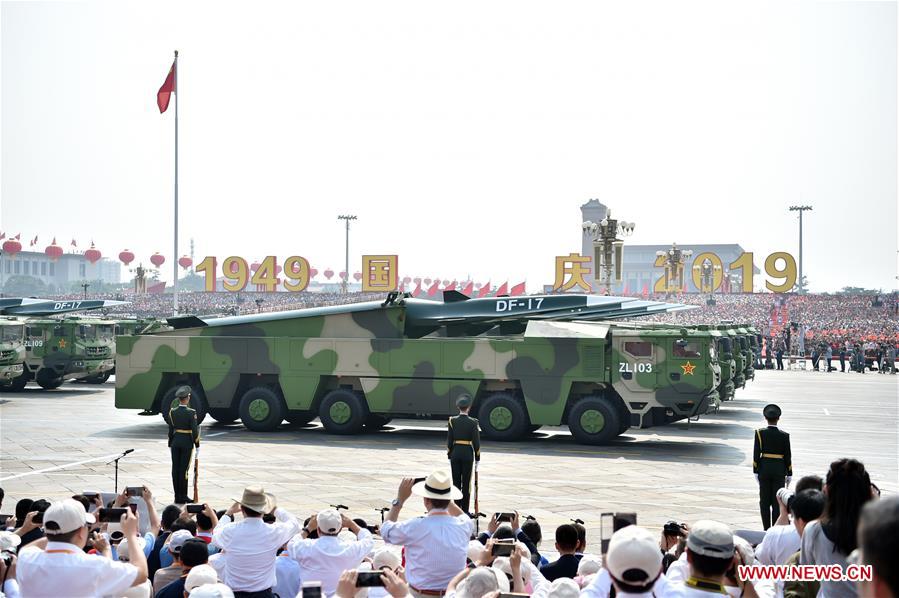
DF-17 hypersonic missiles at China’s 70th anniversary military parade
Bill Greenwalt worked hand in glove with the late Sen. Sen. McCain as he tried — and repeatedly failed — to cleanse the defense budget of huge amounts of what isn’t really defense spending — cancer research, health care, grocery stores and the list goes on and on. If you strip this from the defense budget how much is America really spending on its military and how does that compare with what China is spending? Read on! The Editor.
Adam Smith, chairman of the House Armed Services Committee is under pressure from within his party to hold down defense spending, so he has advocated focusing less on the defense top line and more on the value of what the U.S. gets from its defense budget.
Since the Chinese threat is the driving threat for the Biden Administration, focusing on value for the fiscal 2022 budget may render some surprising answers and implications when comparing the value of US vs. the PRC’s defense spending.
New data indicates that, despite China’s ridiculously low official defense spending figures, the value of its defense budget may have surpassed what the U.S. actually spends on defense. If true this does not comport to the narrative that the U.S. remains decades ahead of China and has time to pivot to Asia in a predictive fashion by incrementally shifting resources within the existing budget.

Bill Greenwalt
Predicting and opining on the significance of changes in U.S. defense spending is one of Washington’s favorite parlor games. Despite persistent calls by civilian and uniformed officials for a 3 to 5% annual budget increase to compete with China, the Trump Administration ignored this advice and cut the budget for fiscal 2021. As a result, this year the Pentagon is executing a $740 billion budget – $705 billion for the Pentagon and the remainder primarily for DOE nuclear programs. This Friday the Biden Administration is expected to propose a 2022 budget that will likely be less than inflation. One part of the Democratic Party (fondly known as progressives) are pushing for a 10% cut. This is why the perceived low rate of Chinese military spending is crucial.
The trope that the U.S. outspends the next 10 countries in defense combined regularly gets trotted out to explain why defense spending might go lower. The U.S. can limit defense spending and still meet our national security needs is the argument that resounds in the halls of OMB and the appropriations committees.
In popular terms, the case is made that we can buy more butter and fewer guns and still be safe. National security advocates often counter this with the somewhat thin argument that we must spend more because the U.S. has more interests than anyone else in more places around the world. What if these arguments and the basic assumptions on both sides are mistaken? What if we are not spending more and are achieving less value from what we spend than our adversaries?
The first data point in this journey of discovery comes from the Stockholm International Peace Research Institute (SIPRI) that adjusts the “official” Chinese defense spending of $184 billion to $252 billion. Then things get interesting. This month the Economist published an analysis based on a defense purchasing power parity (PPP) methodology developed by an Australian professor that is similar to other algorithms used to compare country GDPs. PPP calculations are done to try to make apples to apples comparisons in what things cost and the value one gets from spending across different economies. For example, new American military recruits cost 16 times more than they do in China. Having consolidated global manufacturing, it should come as no surprise that it is cheaper to build things like warships and missiles in China. There is a reason China’s navy is now the largest in the world.
The Economist calculates that real Chinese spending in 2020 is $518 billion — double SIPRI’s estimate. In 2021, China says it plans to increase its defense budget by 6.8%, which would raise this estimate to around $550 billion. That would still leave the U.S with a more than a $190 billon annual cushion.
Unfortunately, that lead quickly evaporates when one takes into account a statement made last week by Rep. Anthony Brown, the Democratic vice chair of the HASC. Brown came clean in an op-ed about the share of non-defense spending embedded in the U.S. defense budget. His statement was clearly targeted at the progressive wing of his party since his arguments, boiled down, is that defense spending isn’t all that bad because much of it actually isn’t really defense spending.
For decades, Senator McCain battled the the juggernaut of liberals and Willie Sutton style appropriators who understood that the Bank of the Department of Defense was where the money was. What was not clear, until Rep. Brown’s article, was the scale of this expropriation — to the tune of $200 billon a year. “We spend $1 billion more on Medicare in the defense budget than we do on new tactical vehicles. We spend more on the Defense Health Program than we do on new ships,” Brown wrote. “In total, some $200 billion in the defense budget are essentially for non-defense purposes.” Even McCain would have been flabbergasted by the scale of this number.
Removing this $200 billion of non-defense spending from U.S. defense spending would leave the effective rate of U.S. defense spending below the Chinese estimate, at around $540 billion. On top of that, DoD doesn’t spend all of its money due to misguided appropriations and budget rules and is now leaving around up to $20 billion each year on the table that is eventually returned to the Treasury. So, the Chinese spending equivalent of $550 billion which continues to rise over 6% each year is significantly above the actual U.S. spending rate of around $520 billion that in the current best case will struggle to keep up with inflation. Bottom line: time is not on America’s side.
Of course, top-line budget comparisons will remain fraught. The Chinese will continue to hide defense spending while the U.S. is committed to hiding social spending in its defense budget. Improved analysis and the use of productivity and PPP-like measures will be critical in the future to try and make sense of what the world’s two greatest powers are really doing.
As Congress considers this, it first needs to understand that the U.S. is likely on the precipice of being outspent and after that will fall further behind every year. Real military spending must increase at the same time that radical changes are made to acquisition and budgeting.
Congress should include several hundred billion dollars in the upcoming infrastructure bill as an initial downpayment to rebuild our naval shipyards and modernize the defense industrial base. Lawmakers should also immediately transfer non-defense spending from the defense budget to the agencies that actually should do it and then spend the freed up balances on new weapons. Finally, current appropriations rules and culture need to change to incentivize budget savings and allow that free cash flow to be spent where the military can add significant value to compete against China.
Without these steps, extremely dire implications wait just around the corner for our nation, and for free peoples everywhere.






















